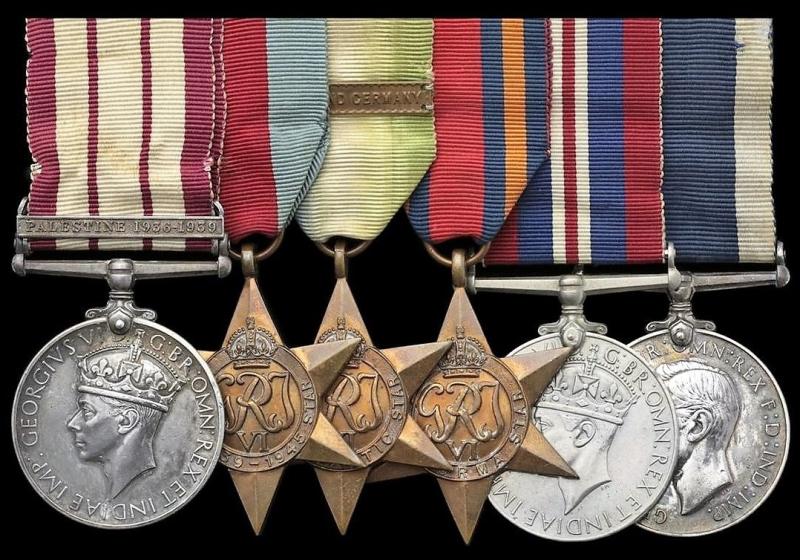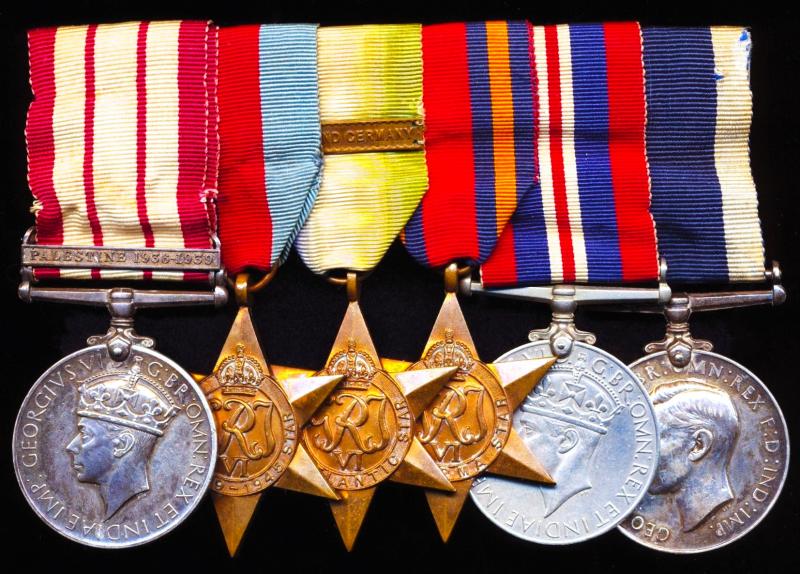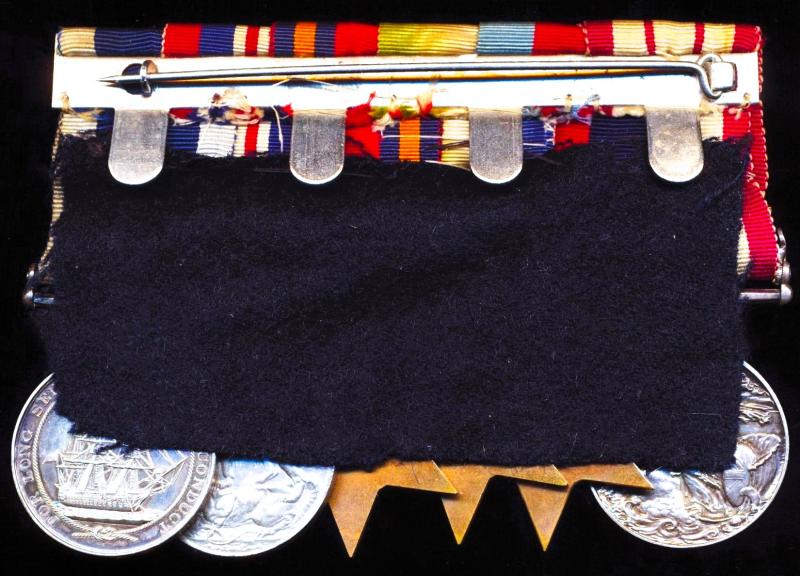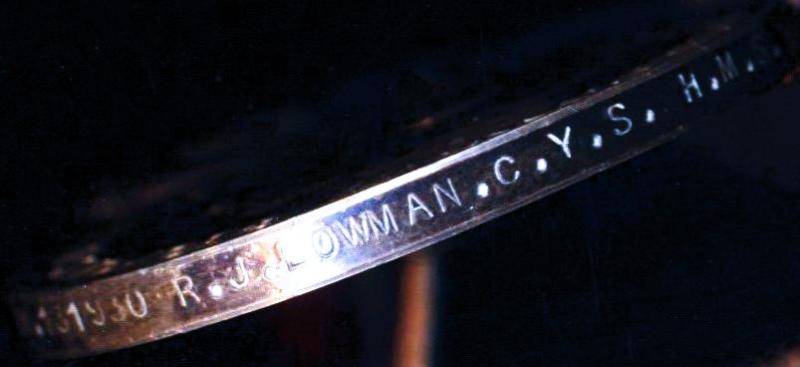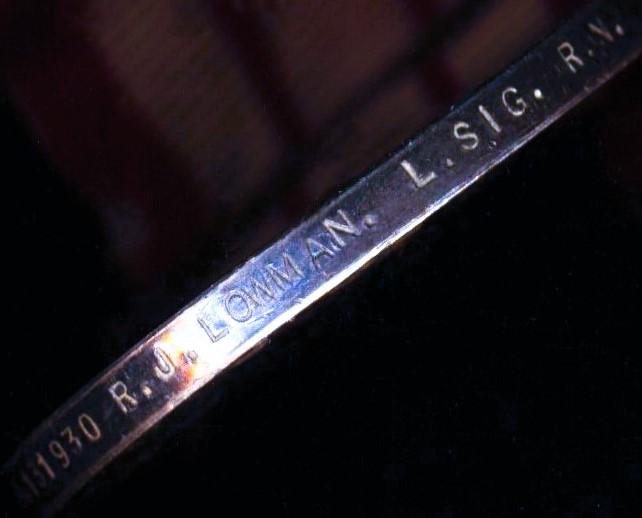A superb 'WW2' naval medal group of 6 - Dunkirk, Arctic Convoys & D-Day, & present at the Battle of North Cape, against the the 'Scharnhorst': Chief Yeoman of Signals Reginald John Lowman, RN
- NGSM 1915-62. 'Palestine 1939-36' (JX. 131930 R. J. Lowman, L. Sig., R.N.)
- The 1939-45 Star
- The Atlantic Star. With clasp 'France and Germany'
- Burma Star
- War Medal 1939-45
- Naval LSGC. GVI issue (JX. 131930 R. J. Lowman, C.Y.S., H.M.S. Braganza)
Note: The Naval LSGC with minor official corrections to ships name - and typical thus
H.M.S. Braganza: A rare named LSGC to the Naval 'Shore Base' at Bombay, India, that was commissioned for less than 3 years. The base was located in the outskirts at Chembur, in the North West outskirts of Bombay (now Mumbai) Commissioned 1 September 1943 and Paid Off on, 30 June 1946
Medals verification: The Naval General Service with clasp & Long Service Medals both entered on his 'Service Sheet' as under:
- Naval General Service 1915-62, & clasp 'Palestine 1939-36': Traced (awarded for service aboard H.M.S. Despatch, 1936)
- Naval Long Service & Good Conduct Medal: Traced 27 November 1945
Synopsis: Having undertaken sterling service in the flotilla leader H.M.S. Codrington on the Dunkirk run, he removed to the destroyer H.M.S. Saumarez and faced the full fury of the German battleship 'Scharnhorst' at the battle of North Cape in, December 1943
In an 11-minute exchange with her mighty opponent - in which she claimed a torpedo strike - 'Saumarez' was lucky indeed to avoid destruction, one of Scharnhorst's shells passing right through her Director Control Tower without detonating: it nonetheless killed 11 men.........
DUNKIRK: By the outbreak of hostilities, he was serving as a Leading Seaman in the flotilla leader H.M.S. Codrington but quickly gained advancement to Acting Yeoman of the Signals
On 28 May 1940, 'Codrington' assisted in the rescue of 32 survivors from the torpedoed Aboukir in the North Sea, following which she made haste to Dunkirk's East Mole. Thereafter, over the coming week, she carried out a punishing agenda of return trips to Dover, eventually bringing home over 6,000 troops, among them Major-General B. L. Montgomery:
'Saturday 1 June: Secured alongside eastern pier, Dunkirk, at 0525 hours. Embarked about 500 troops, including Major-General B. L. Montgomery, temporarily commanding a corps. The latter informed me that embarkation at Braye had been very difficult due to the pier being unsuitable. While in Dunkirk harbour low cloud persisted and several low bombing attacks took place ... one Heinkel was brought down apparently by the fire of 'Codrington' and another destroyer' (Stevens-Guille's official Operation "Dynamo" report refers).
'Codrington' having then been damaged - and bombed and sunk in Dover harbour in the following month - Lowman removed to the minelaying cruiser 'Adventure'. He remained similarly employed until August 1942 and would have been present on the occasion she was mined off Liverpool in 1941.
ARCTIC CONVOY's & "SINK THE SCHARNHORST": In May 1943, Lowman joined the destroyer H.M.S. Saumarez and he remained likewise employed until January 1945, a period encompassing good work on the Arctic Convoy's, in addition to the destruction of the Battleship 'Scharnhorst' at the battle of North Cape.
On 22 December 1943, Convoy RA 55A sailed from Kola, escorted by eight destroyers, including 'Saumarez', two Canadian destroyers, three corvettes and a minesweeper. The outgoing convoy, JW 55B, had left Loch Ewe on 20 December and was expected to reach Bear Island on Christmas Day about the same time as RA 55A. Cruiser cover was provided east of Bear Island by 'Belfast', 'Sheffield' and 'Norfolk', and heavy cover by the battleship 'Duke of York' and the cruiser 'Jamaica'.
Early on 26 December the Admiralty signalled that the German battleship 'Scharnhorst' was at sea. She was detected by the cruisers and after some hours trying to evade them and strike at the convoy, headed for home. But the 'Scharnhorst' was intercepted and hit by 'Duke of York' and a long chase followed. In the ensuing action, 'Saumarez's' guns fired continuously for eleven minutes, followed by the delivery of a telling torpedo attack. A shell from 'Scharnhorst', which did not explode, passed through her Director Control Tower, killing eleven men and putting the tower out of action. A near miss also damaged the ship's forced lubrication system
'Saumarez' steamed to Murmansk on one engine and, after temporary repairs by the Russians, left for the U.K. Following a refit, completed in March 1944, she was again part of the escort of a pair of Arctic convoys, JW 58 and RA 58, both of which reached their destinations unscathed. The successful Fleet Air Arm attack on the German battleship 'Tirpitz', which took place on 3 April, was synchronised with the passage of JW 58
D-DAY & NORMANDY LANDINGS (OPERATION NEPTUNE): In Operation "Neptune" on 6 June 1944, Saumarez acted as leader of the 23rd Destroyer Flotilla and lent valuable gun support to Force S in the assault on Ouistreham
Later still, in mid-August, 'Saumarez' and her consort 'Onslaught' engaged a convoy of three or four enemy minesweepers and one merchant vessel off St. Peter Port, Guernsey. The convoy was frequently hit but both destroyers also sustained damage and casualties.
In September 'Saumarez' was part of the escort of another Arctic convoy and Lowman departed her when she returned to Newcastle for a refit in January 1945
Reginald John Lowman eldest son of William Hugh Lowman and Ellen Louisa Lowman (nee Legg) was a native of, Weymouth, Dorset, England, where he was born on, 9 March 1913. Described as prior employed as a 'Errand Boy', he entered the Royal Navy as a Boy 2nd Class in July 1928. He subsequently qualified for his Naval General Service Medal for services off Palestine in H.M.S. Despatch. After a remarkable Naval career, in which he had participated in numerous famous actions of the Second World War, Chief Yeoman of Signals, Reginald Lowan was finally pensioned ashore, on, 23 October 1953 Reginald is recorded to have died in Somerset, England, on, 19 February 1978
Sold together with soft copies of the recipients extant 'Service Sheet's' that will be forwarded to the buyer by email attachment
The medals mounted as-worn by the recipient in the swing-style. The reverse of the mounting bar retaining the original long pin & clasp fittings
A superb Naval Combat group & including a 'rare to ship' Naval LSGC to a very short-lived India shore-base!
Condition: GVF
Code: 22396



